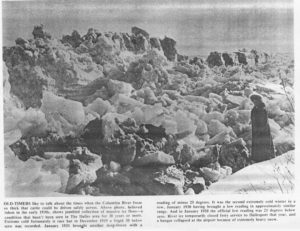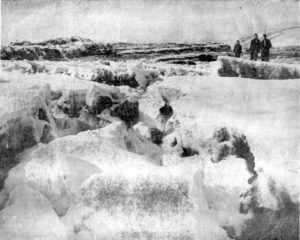A Common Cold

We have just experienced “Snowpocolypse 2016.” It snowed from noon to 10 p.m., depositing an amazing 8 inches of the white stuff at our front door. Our neighbors 80+ miles to the west in “P-Town” (read: Portland), found their metro area “shut down” for hours as they struggled with 2 inches of slick ice and snow.
Is this common? Historically speaking, no. What WAS “common” was to have the river freeze over and shut down river traffic completely for months. We have a memory of our own grandfather who recalled taking a horse across the Columbia River on ice, sans bridge or ferry.

In perusing history, we found a reference to the 1862 coldest temperature recorded in The Dalles, of -24 degrees. The little chill from the current +22 degrees today is a trifling in comparison.
Ben Snipes, the Pacific Northwest Cattle King, lost 90% of his herd during the winter of 1861. Estimates of his cattle holdings in the fall of that year were between 25,000 to 40,000 head of cattle. But in 1861, better than a foot of snow fell during the early part of that winter, to be followed by rain, which in turn was succeeded by intense cold, to be followed by a second two feet of snow followed by rain drizzles. By the closing days of December there was an ice-cap of this character about three feet in depth. By the time Chinook winds came in February, about 10 percent of the cattle remained alive. Gullies were deep with decaying carcasses, where the cattle, seeking each other’s warmth and companionship in their suffering, died together when the Chinook failed to come soon enough.

The Dalles’ leading politician and business entrepreneur, Victor Trevitt, died of consumption in San Francisco on January 23, 1883. Trevitt had asked to be buried on Memaloose Island, which was the traditional burial site for the area’s Native people. The problem was the river was frozen at the time of his death. His funeral was delayed due to temperatures of -20 degrees. Access to the island was closed at the time with ice, and heavy snow had fallen; so Trevitt’s body was placed in a snow bank until the river should open and steamboat traffic be resumed. His funeral was finally held on March 10, 1883. He had a Masonic funeral. Trevitt was the only white man to be buried on Memaloose Island. He said, “I have but one desire after I die, to be laid away on Memaloose Island with the Indians. They are more honest than whites and live up to the light they have. In the resurrection I will take my chances with the Indians. I won’t have any chance to get into heaven unless I slip in with the Indians. When Gabriel blows his horn on the last day, I will get up with the Indians, wrap my blanket about me and slip in with them and St. Peter will never notice me.”
These recollections will hopefully bolster your courage as you head out the door to shovel the mere eight inches from the “2016 Snowpocolypse.”